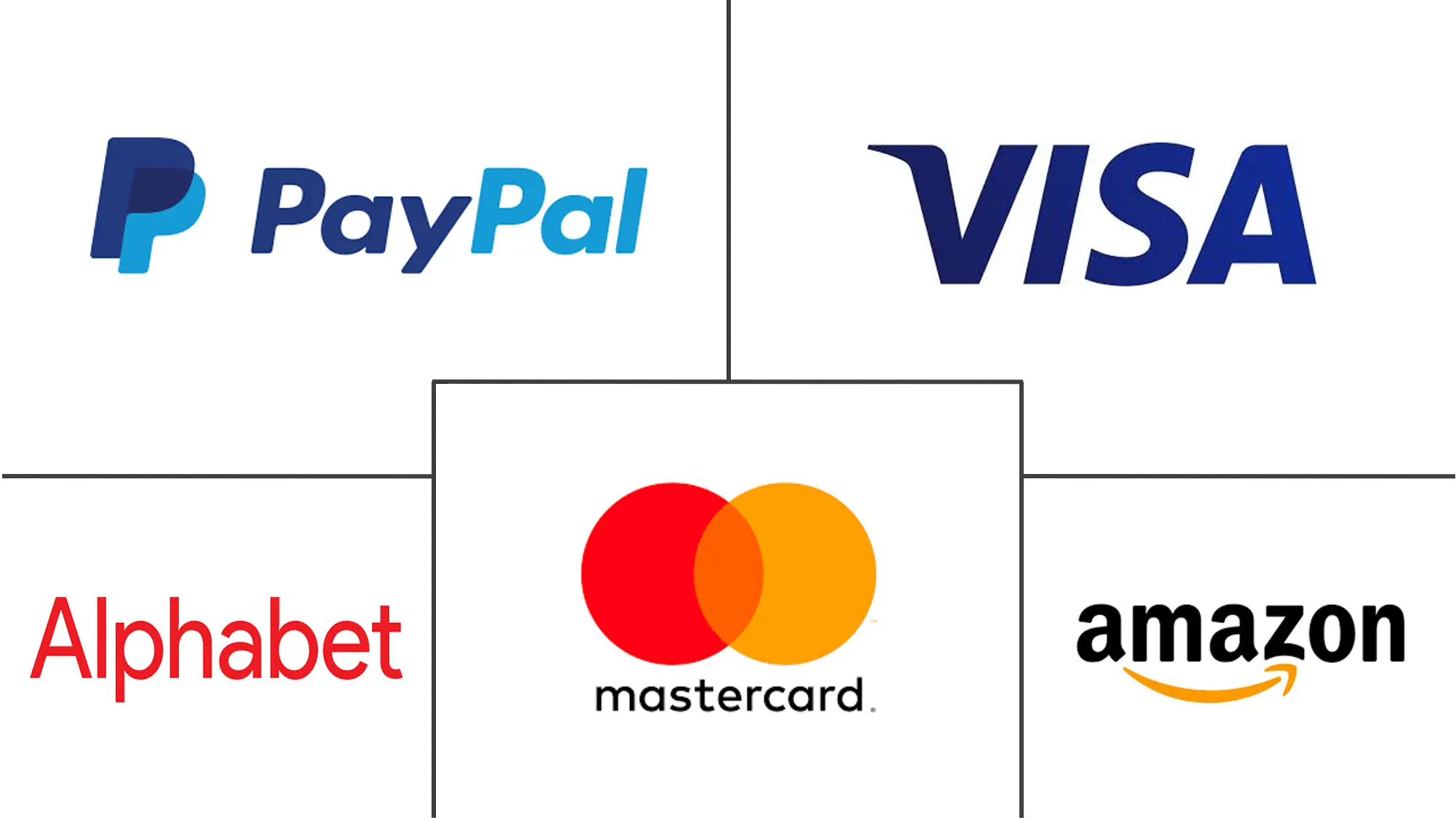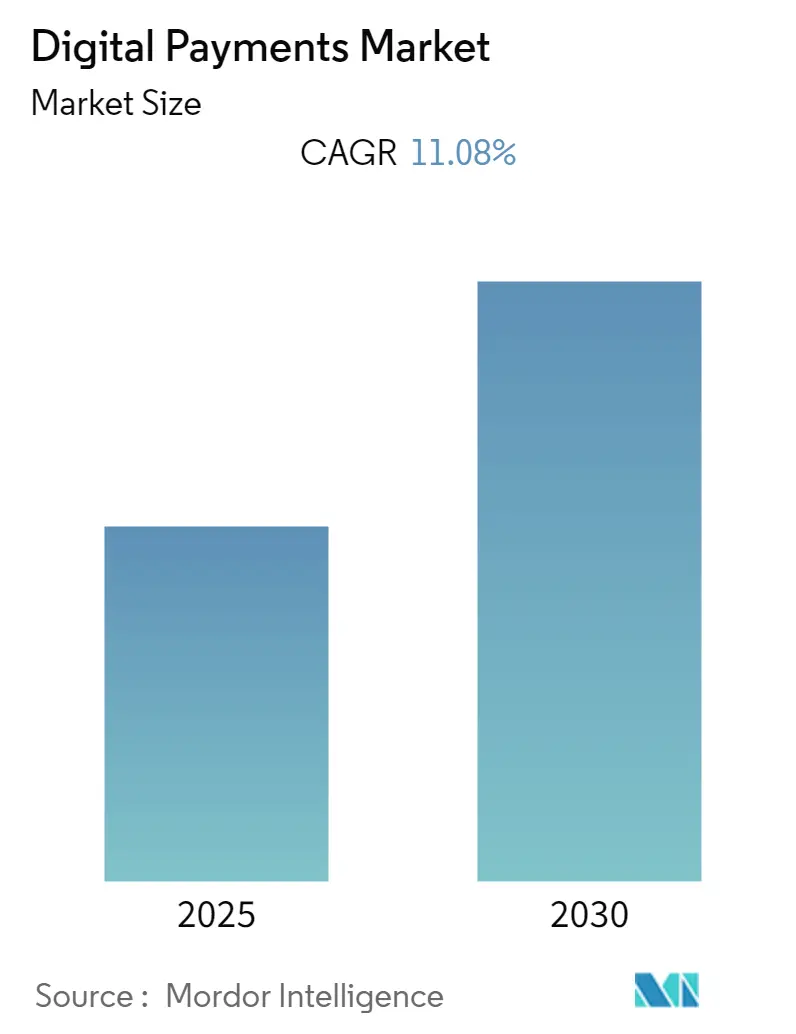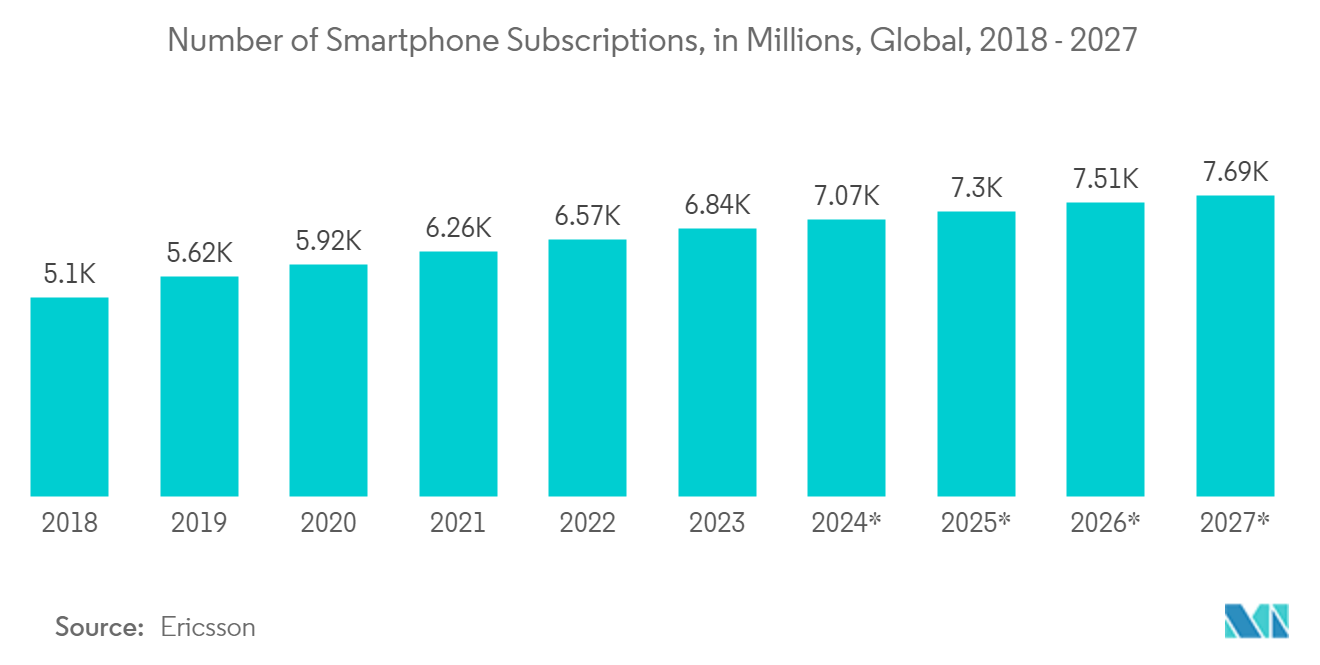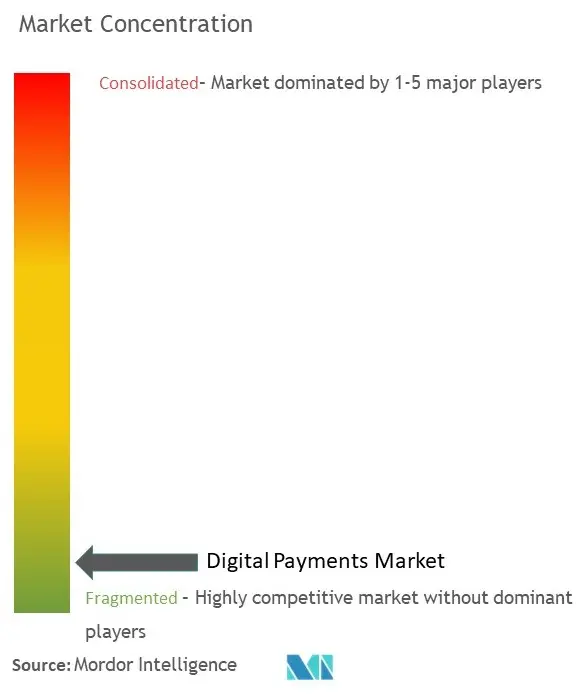Digital Payment Market Analysis
The Digital Payments Market is expected to register a CAGR of 11.08% during the forecast period.
- The widespread launch of mobile wallets and the rise in various technological developments in smartphones, digital payment cards, and POS at retail terminals are fueling the expansion of the market. The market's growth is anticipated to be positively impacted by the quick increase in smartphone penetration across emerging economies.
- Governments are introducing digital payment options to their initiative toward a digitalized and cashless society. The emergence of Bring Your Own Device(BYOD), an increase in the usage of smartphones, and a vast number of individuals without bank accounts are some of the crucial factors expected to offer lucrative growth opportunities for digital payments.
- Moreover, stores and services worldwide are rapidly adopting and integrating mobile payment applications like PayPal, Samsung Pay, Apple Pay, AliPay, and WeChat Pay. These apps accept digital payments. This trend and scenario are anticipated to continue over the projected period due to changing lifestyles, daily commerce, and rapid growth in online retailing. Although card-based transactions account for a sizeable portion of non-cash transactions, growth has slowed due to local and regional payment methods like EuPay, EPI, and Verve Card, which are challenging the worldwide card market.
- Vendors are also launching cloud-based digital payment solutions. For instance, in October 2022, Mercury Payment Services used Oracle banking payments that run on Cloud Infrastructure to help democratize digital payments in the United Arab Emirates. Additionally, banks are innovating their digital payment products to integrate with a complete health ecosystem.
- The increase in international trade, internationalization of production, and cross-border e-commerce suggest that demand for digital cross-border payments will continue to grow globally. However, digital payments from one country to another might prove to be costlier, slower, and less transparent than domestic payments due to the complexity involved in the procedure. This might hinder the growth in adopting digital payments for cross-border transactions amongst regional enterprises, especially small and medium-sized businesses.
- The wide acceptance of digital payment methods is expected to augment post-COVID-19 and play a significant role in the long-term market scenario. With cash being a potential carrier for the virus, regulatory bodies and governments discourage its use. For instance, cash use in Britain has halved in recent days following the government-imposed lockdown, and essential goods stores are increasingly avoiding cash transactions. Various mobile payment vendors in the market are expected to focus on increasing their user base during this period and return to post-COVID-19 scenarios, owing to which vendors offer benefits and offers and waive their fees for using their services.
Digital Payment Market Trends
Retail End User Industry is Expected to Hold Significant Market Share
- Digital payments have become increasingly popular in retail as businesses and consumers embrace convenience and efficient transactions. The rise in online shopping has significantly influenced the adoption of digital payments in retail. E-commerce platforms and online retailers integrate digital payment methods, such as credit/debit cards, mobile wallets, and digital payment gateways, to facilitate secure and seamless transactions.
- Traditional brick-and-mortar retailers are also transitioning to digital payment solutions at their physical stores. Modern POS Systems often incorporate digital payment capabilities, enabling customers to make payments using contactless methods like NFC (Near Filed Communication), mobile apps, and QR codes.
- According to the US Census Bureau, In Q4 2022, e-commerce sales amounted to 14.7 percent of total revenues. In the United States, wallets exceeded credit cards in 2022 and are estimated to account for roughly one-third of regional e-commerce expenditure in three years, headed by Amazon Pay, Apple Pay, Google Pay, and PayPal.
- E-commerce is witnessing a spike in demand as consumers order essential items such as food, clothes, and others through e-commerce websites. Most consumers prefer the digital mode of payment. The Reserve Bank of India's (RBI) digital payments index (DPI), launched in January to indicate the extent of digitization of payments in India, shows the index for September stood at 304.06 against 270.59 in March. This means the rapid adoption and deepening of digital payments across the country.
- According to Ericsson's data, global smartphone subscriptions were around 6,567 million last year. It is expected to reach approximately USD 6,841 million by the end of the current year. Additionally, it is forecasted to reach a landmark of roughly 7,690 million in four years. Hence, with the rise in the total number of smartphone subscriptions worldwide, the market for Digital Payments is presumed to face a vast range of lucrative growth opportunities in the upcoming days.
North America is Expected to Hold Significant Market Share
- North America represents one of the largest digital payment markets globally. The region's advanced technological infrastructure, high internet penetration rates, and a large base of tech-savvy consumers contribute to the market's growth. The market continues to expand as businesses and consumers increasingly adopt digital payment solutions.
- Mobile payment solutions play a significant role in the North American market. Mobile wallets like Apple Pay, Google Pay, and Samsung Pay have gained widespread acceptance. These wallets enable users to pay using smartphones, leveraging technologies such as NFC and QR codes.
- As per the data forecast from the US Census Bureau, there is a USD 1.7 billion increase in the sales value of smartphones sold in the United States, for a total of USD 74.7 billion in sales in the previous year. Therefore, with this rise in the total number of smartphone users and the increase in the sales value of smartphones, it is evident that the market for digital payments in the region will face various growth opportunities in the coming era.
- The digital payment market in North America is closely intertwined with the thriving e-commerce sector. Online retailers and e-commerce platforms provide digital payment options to facilitate secure and convenient transactions.
- Digital payments in the region are characterized by continuous innovation and collaboration between technology companies, financial institutions, and merchants. In April 2023, Visa partnered with PayPal and Venmo to pilot Visa+. This innovative service aims to assist individuals in moving money securely between different person-to-person (P2P) digital payment apps. Later this year, Venmo and PayPal users in the United States can start transferring money seamlessly between the two platforms. Visa+ would not require users to have a Visa card; instead, by setting up a personalized payment address linked to their Venmo or PayPal account, individuals using either app can receive and send payments quickly and securely between the platforms.
Digital Payment Industry Overview
The Digital Payments Market is highly fragmented, with the presence of major players like PayPal Holdings Inc., Visa Inc., Mastercard Incorporated (Mastercard), Amazon Payments Inc. (Amazon.com Inc.), and Alphabet Inc. Players in the market are adopting strategies such as partnerships and acquisitions to enhance their product offerings and gain sustainable competitive advantage.
In July 2023, Mastercard announced a collaboration with JazzCash, one of Pakistan's most prominent digital wallet providers, serving over 43 million accounts, to revolutionize digital payments by introducing affordable acceptance solutions. The partners launched QR code payments, Tap on Phone solutions, and Pay by Link to facilitate cost-effective and widespread acceptance for merchants at the bottom of the economic pyramid.
In December 2022, Payments technology giant Visa invested USD 1 billion in its business across Africa in the next five years to promote the adoption of digital payments in the region. The move is targeted to provide individuals and merchants with additional access to digital payments. The move is part of the company's strategy to strengthen its business in Africa and extend its alliance with strategic partners such as governments, financial institutions, mobile network operators, fintechs, and merchants.
Digital Payment Market Leaders
-
Paypal Holdings Inc.
-
Visa Inc.
-
Mastercard Incorporated (Mastercard)
-
Amazon Payments Inc. (Amazon.com Inc.)
-
Alphabet Inc.
- *Disclaimer: Major Players sorted in no particular order
Digital Payment Market News
- June 2023: PayPal Holdings, Inc. and KKR, one of the leading global investment firms, announced the signing of an exclusive multi-year agreement for a EUR 3 billion (USD 3.37 billion) replenishing loan commitment under which private credit funds and accounts managed by KKR will purchase up to EUR 40 billion (USD 44.87 billion) of buy now, pay later (BNPL) loan receivables originated by PayPal in Italy, France, United Kingdom, Spain, and Germany.
- February 2023: HDFC Bank has launched a pilot in partnership with Crunchfish to test offline digital payments for merchants and customers under the RBI's Regulatory Sandbox Program, known as OfflinePay.
- November 2022: As part of its initiative to speed up the digital transformation of Egypt's financial ecosystem, Mastercard has announced a long-term strategic partnership with the Arab African International Bank (AAIB). Through this partnership, Mastercard and AAIB would concentrate on planning and executing AAIB's digital transformation strategy and delivering advanced payment solutions that satisfy the growing consumer demand for simple and secure digital payment methods.
Digital Payment Industry Segmentation
Digital payment is made using digital channels. Both the payer and the payee send and receive money using digital methods in digital payments. Another name for it is electronic payment. Digital payments don't include real money. Per industry standards, DP is called non-cash transactions via digital platforms. The report's purview is limited to consumer transactions made through digital commerce (payments made through online payment gateways for card payments, direct debit, and mobile point-of-sale transactions).
The Digital Payments Market is segmented by mode of payment (point of sale and online sale), by end-user industry (retail, entertainment, healthcare, hospitality), and by geography (North America, Europe, Asia Pacific, Latin America, and Middle East and Africa).
The market sizes and forecasts are provided in terms of value in USD for all the above segments.
| By Mode of Payment | Point of Sale |
| Online Sale | |
| By End-user Industry | Retail |
| Entertainment | |
| Healthcare | |
| Hospitality | |
| Other End-user Industries | |
| By Geography | North America |
| Europe | |
| Asia Pacific | |
| Latin America | |
| Middle East and Africa |
Digital Payment Market Research FAQs
What is the current Digital Payments Market size?
The Digital Payments Market is projected to register a CAGR of 11.08% during the forecast period (2025-2030)
Who are the key players in Digital Payments Market?
Paypal Holdings Inc., Visa Inc., Mastercard Incorporated (Mastercard), Amazon Payments Inc. (Amazon.com Inc.) and Alphabet Inc. are the major companies operating in the Digital Payments Market.
Which is the fastest growing region in Digital Payments Market?
Middle East and Africa is estimated to grow at the highest CAGR over the forecast period (2025-2030).
Which region has the biggest share in Digital Payments Market?
In 2025, the North America accounts for the largest market share in Digital Payments Market.
What years does this Digital Payments Market cover?
The report covers the Digital Payments Market historical market size for years: 2019, 2020, 2021, 2022, 2023 and 2024. The report also forecasts the Digital Payments Market size for years: 2025, 2026, 2027, 2028, 2029 and 2030.
Our Best Selling Reports
Digital Payment Industry Report
The digital payment industry is undergoing significant transformation, driven by the increasing adoption of smartphones and internet access globally. Innovations such as mobile wallets and advanced payment processing solutions are enhancing consumer convenience and security. This shift towards cashless transactions, accelerated by the pandemic and a preference for contactless payments, is reshaping the financial landscape. Governments worldwide are promoting digital payments to improve financial inclusivity and streamline economic activities.
Despite challenges like payment fraud and the need for robust security measures, the growth of digital payments continues to offer enhanced transaction efficiency and accessibility across various sectors including retail, e-commerce, and BFSI. As the market evolves, regulatory frameworks and technological advancements play crucial roles in shaping its future trajectory.
Industry analysis reveals that market growth is driven by the increasing demand for digital solutions. The industry outlook remains positive, with market predictions indicating sustained expansion. Market segmentation shows diverse applications across different end-user industries. Market leaders are continually innovating to maintain their competitive edge.
Industry trends highlight the importance of security and convenience in digital payments. Market forecast suggests a steady increase in market value and market size. The industry information gathered from various industry reports and industry research underscores the importance of adapting to new technologies.
Market overview and market review provide a comprehensive understanding of the current market dynamics. The report pdf available offers detailed market data and industry statistics, essential for understanding market segmentation and market growth. The market outlook remains optimistic with significant potential for future growth.







